Table of Contents
Introduction:
Ah, bengali rasgulla… that soft, spongy ball of sweetness that dissolves in your mouth, leaving a trace of blissful sugariness paired with the subtle tang of fresh cheese. Originating from the rich cultural tapestry of Bengal where it is pronounced as rasogolla. Rasgulla is derived from the words ras( juice ) and gulla ( ball ). Other names for the dish include rossogolla, rasagulla, roshogolla, rasagola, rasagolla and rasbhari or rasbari in Nepali.
Bengali rasgulla holds a special place in the hearts of those who relish Indian sweets. Let’s dive into the origins of this delightful delicacy, explore its cultural significance in Bengal, and trace its mouthwatering journey from being a local favorite to gracing dessert menus across the globe.

The Craft of Bengali Rasgulla Making:
Ingredients for Rasgulla Recipe
1.Paneer/Cottage Cheese: The Soul of Rasgulla
Crafting the perfect rasgulla begins with high-quality paneer, made from curdling milk and straining it to achieve a fine, granular texture. This is the essence of the white sponge rasgulla, giving it its characteristic chewiness.
For making paneer:
- Milk(full fat)-1 litre
- Vinegar- 2 tbsp
- Water- 2 tbsp
2.Sugar Syrup: The Sweet Embrace
The paneer balls are cooked and soaked in a simple sugar syrup, sometimes flavored with cardamom or rose water, which seeps into the balls, giving each bite a lush, sweet flavor.
For dipping syrup:
- Sugar- 1 cup or 250 gm
- Water-2 to 3 cups
- Ice cubes
For cooking syrup:
- Sugar- 2 cups or 500 gm
- Water- 5 cups
- Refined floor( maida )- 1 tbsp
- Water-1/4th cup
3.Cardamom & Rose Water: Enhancing Flavors
A hint of cardamom powder and a splash of rose water are often added to the syrup, lending the bengali rasgullas an exotic fragrance and a subtle depth of flavor.
Watch Bengali Rasgulla Preparation Video
Bengali Rasgulla is such a famous Indian dessert and it is enjoyed world wide. The making of rasgulla recipe that I’m going to share with you all, will make absolutely soft and spongy rasgullas and filled with sugar syrup throughout it’s core. They will melt in mouth and will turn out soft as cotton. It is very simple and easy recipe of rasgulla with simple ingredients. If you follow all the tips and tricks for this recipe, then this recipe will be perfect for you.
The Step by Step Process: An Art and Science:
Now to make bengali rasgulla, two types of sugar syrup are made. The 1st one in which rasgullas are soaked and the 2nd one in which rasgullas are cooked. First of all let’s make the syrup used for dipping(soaking).
Sugar Syrup 1 Preparation:
1. Take 1 cup or 250 gm sugar in a wok. Along with it add 2-3 cups of water. Now turn the stove on and boil the water until the sugar dissolves and the water comes upto a rolling boil.
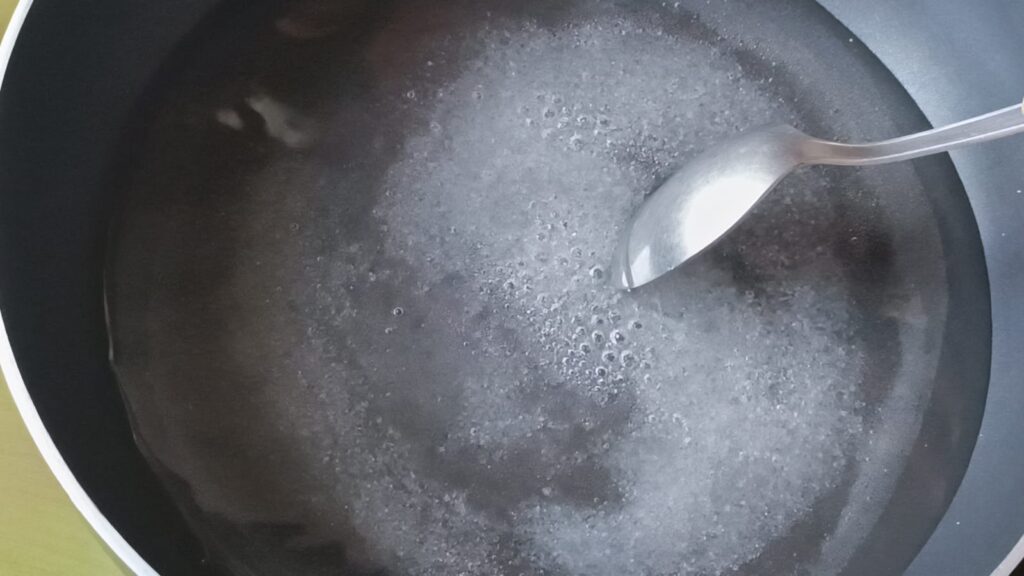
2. When the sugar dissolves totally, after that you don’t have to cook this syrup anymore. Switch off the flame and transfer this syrup into a bowl and bring it to a room temperature.
Remember you don’t have to make thick syrup like we make for gulab jamun. This is very important otherwise your rasgulla will not soak the syrup. We will make the 2nd syrup later.
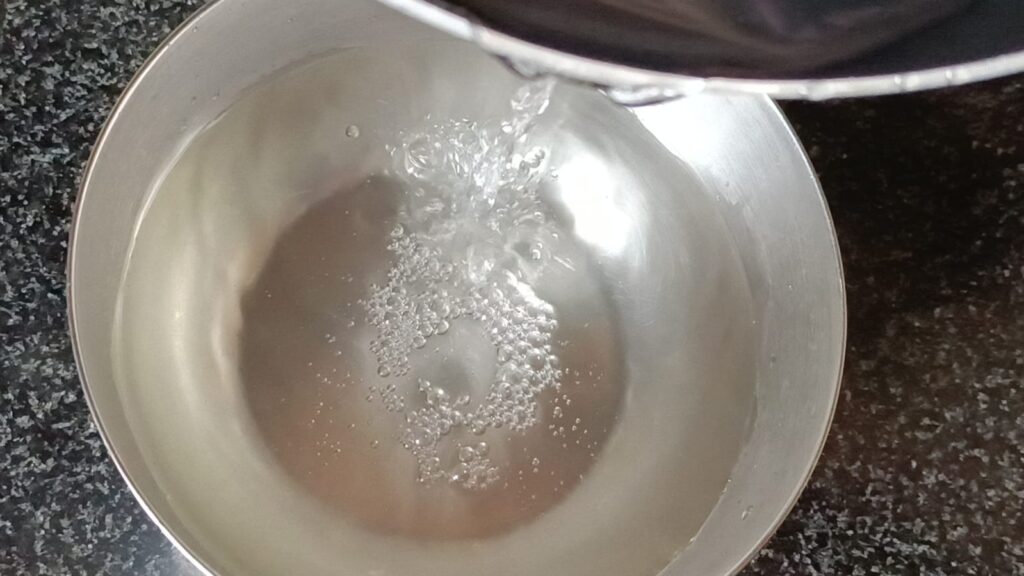
Paneer Preparation:
Now make paneer or chenna for bengali rasgulla. Paneer is basically made by curdling the milk. To make paneer-
3. In a heavy bottomed pan, add 1 litre full fat cow milk, bring it to boiling point. Keep stirring in between while the milk comes upto a boil.

4. When the milk comes to a boil, at this stage you have to turn off the stove and rest it for 1-2 minutes.
If you curdle the milk immediately, then your paneer will be little hard. So keep a note of this.
5. After 2 mins, take 2 tbsp vinegar into a bowl and add water 2 tbsp with it. Now slowly and gradually add this vinegar mixture into the milk and gently stir it with spoon or spatula at regular intervals to prevent it from burning.
6. Now you can see that milk will start curdling. Just use enough vinegar required to curdling the milk.
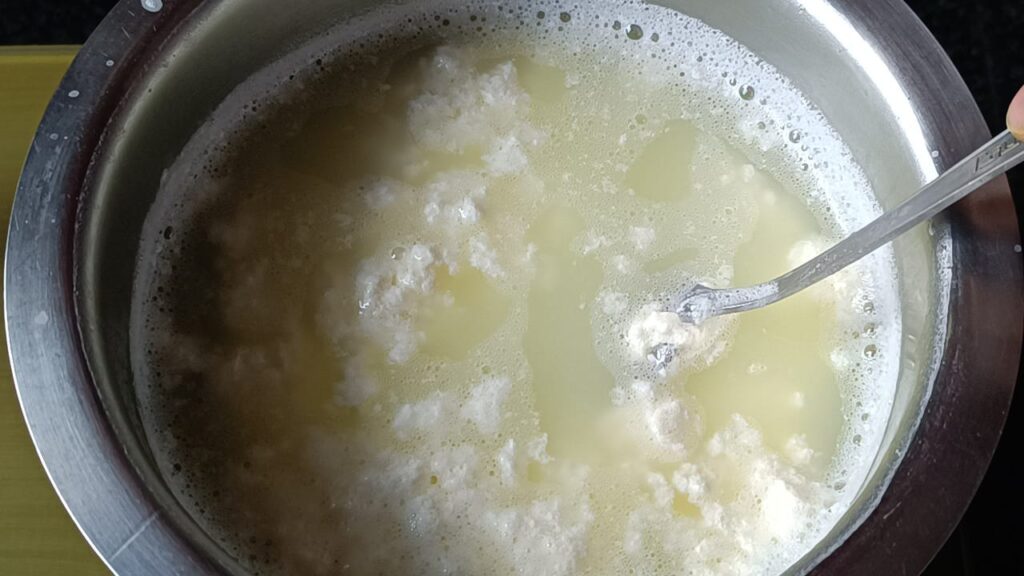
7. You can see that all the milk curds have separated and residual light greenish water is separated too. At this stage you have to strain this curds using a muslin cloth.
8. After straining the paneer, wash it immediately with fresh water to remove the sourness of vinegar. After washing, hang the muslin cloth and let the excess water drip off naturally for 1-2 mins. Squeeze the muslin cloth 2-3 times to remove more water from the paneer.

9. Place it in the sieve and put some weights on it and rest it for 5 mins.

Sugar Syrup 2 Preparation:
10. Now prepare the sugar syrup that you will use to cook the rasgullas in. In a big wok take 2 cups or 500 gm sugar. Add 5 cups of water with this. Now boil this syrup and leave it to come to boil on low flame. While the syrup is cooking on the side till then quickly shape the rasgullas.

Rasgulla Preparation:
11. Transfer the paneer to a plate and crumble it. Use the heel of your hand apply pressure and start rubbing the paneer against the plate, continue doing this until the paneer becomes smooth and stops sticking to the plate. This step is very much important. This will determine that your rasgullas are shaped properly and don’t crack while shaping or boiling and it will make the rasgullas extremely soft.
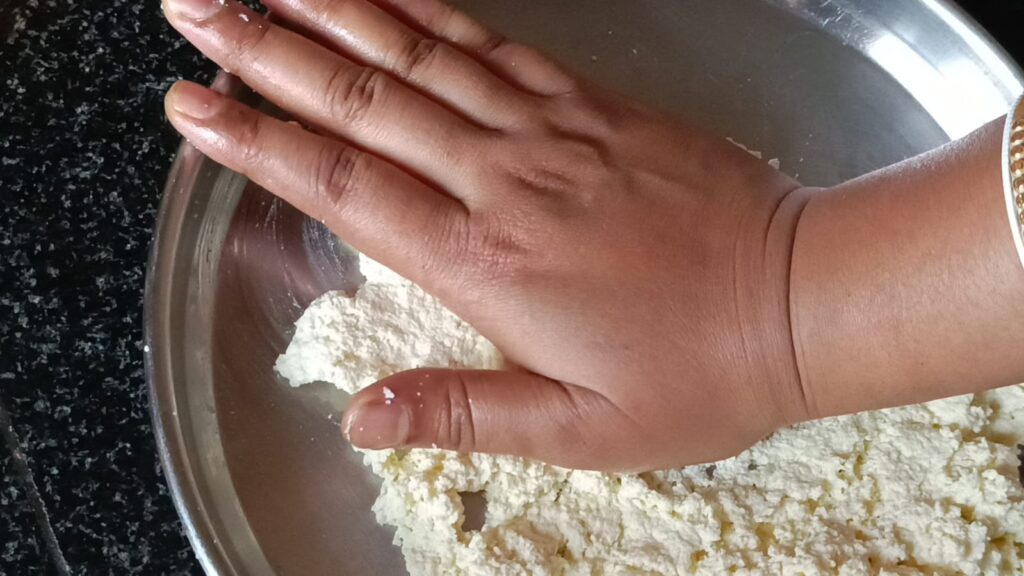
12. At this stage, once the paneer is ready, then add 1 tbsp refined flour (maida) to it. Mix it with the paneer very well. Then you will see that paneer is ready to be shaped.

13. Take a small portion of paneer, place it in between your palms and rub it while rolling it. Apply pressure to form a smooth rounded ball. Make sure there is no cracks on the surface of the ball. Shape all the ball of rasgullas similarly.
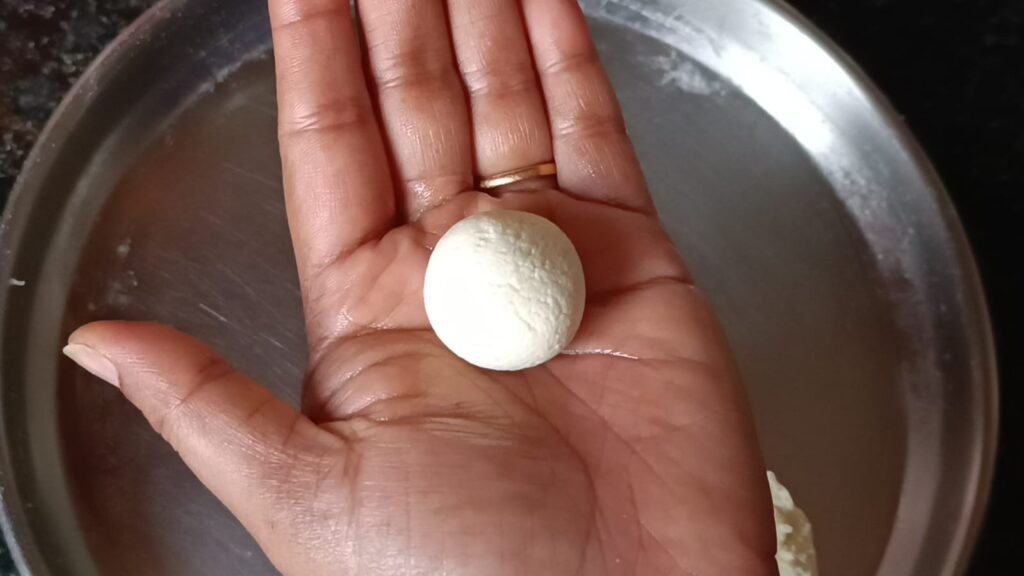
14. Once you start shaping them, cover the remaining paneer by moist cloth to avoid surface drying.
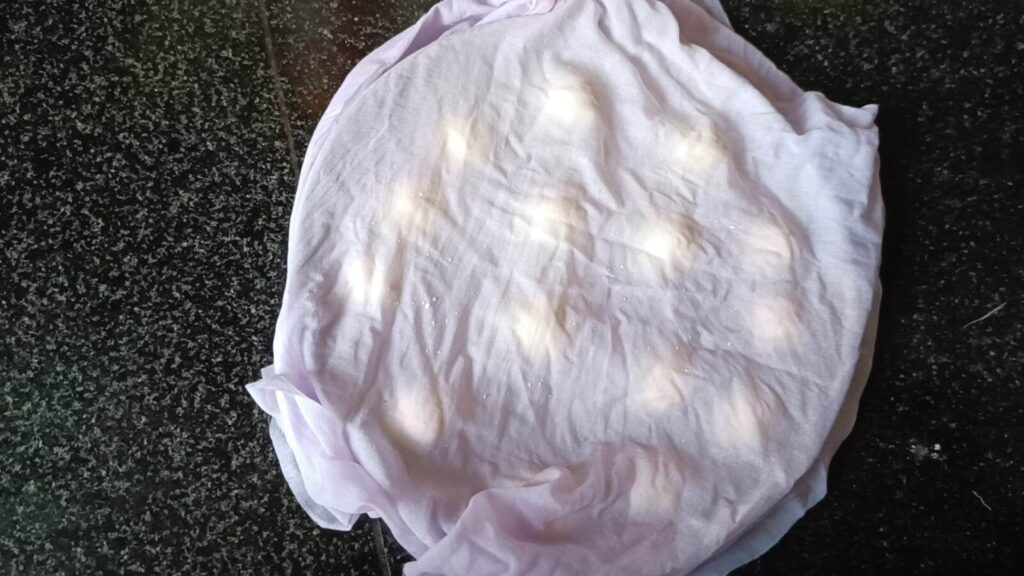
15. Now look at the syrup. Make sure that sugar syrup is not too thick. If you find it thick, then add some more water and cover the lid.
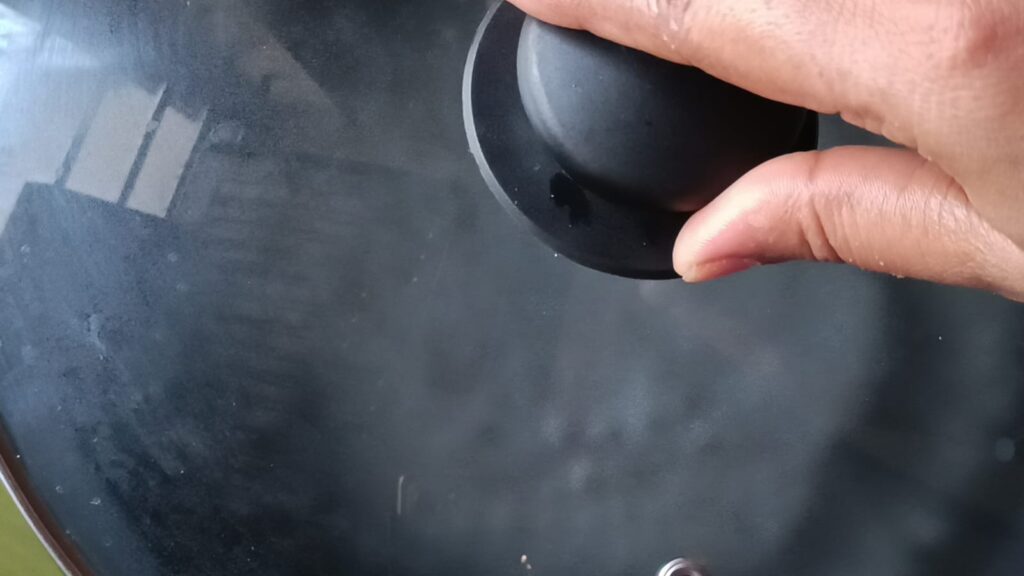
16. While the sugar syrup is coming to a rolling boil make a slurry. Take 1 tbsp refined flour or maida in a bowl and mix 1/4 th cup water with it and keep it aside.
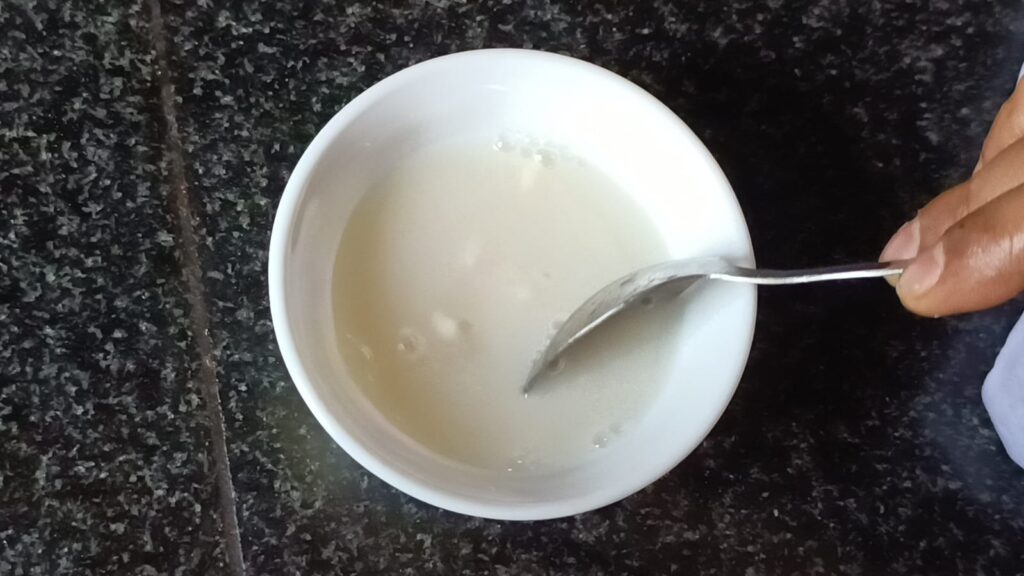
17. Once the sugar syrup comes to a rolling boil, start adding the rasgullas one by one. After adding all the rasgullas cook them on a high flame for 2-3 mins without covering the lid.
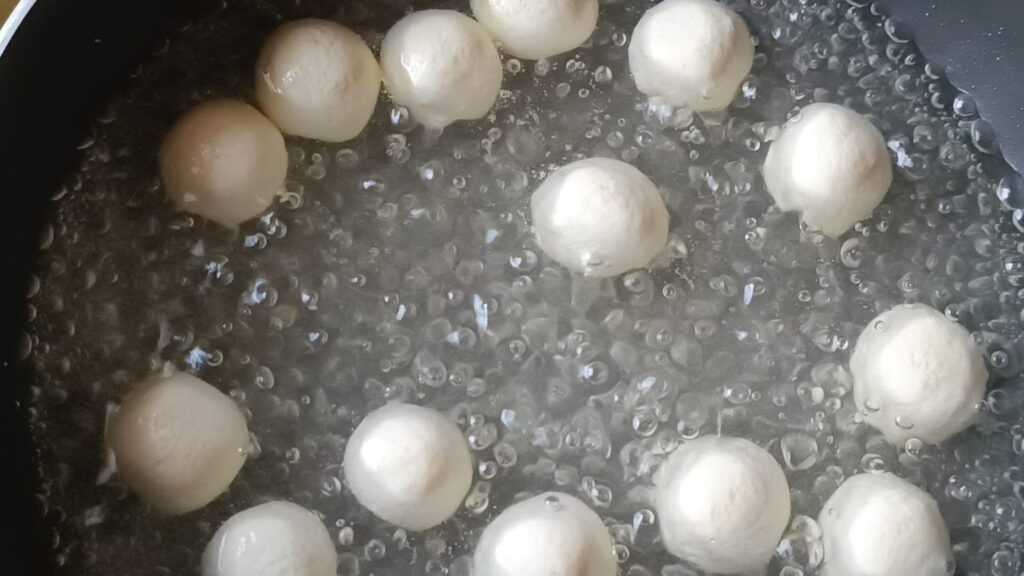
18. After 2-3 mins, add the slurry which you have prepared earlier. Now cover the lid and cook the rasgullas for 10-12 mins. The flour and water mixture will create a lot of froth that will cover the rasgullas from all directions, this will help them to cook evenly and swell up the rasgullas nicely. The froth will start rising to the surface frequently, so you need to keep lifting the lid which will prevent the froth from pouring out of the kadai.
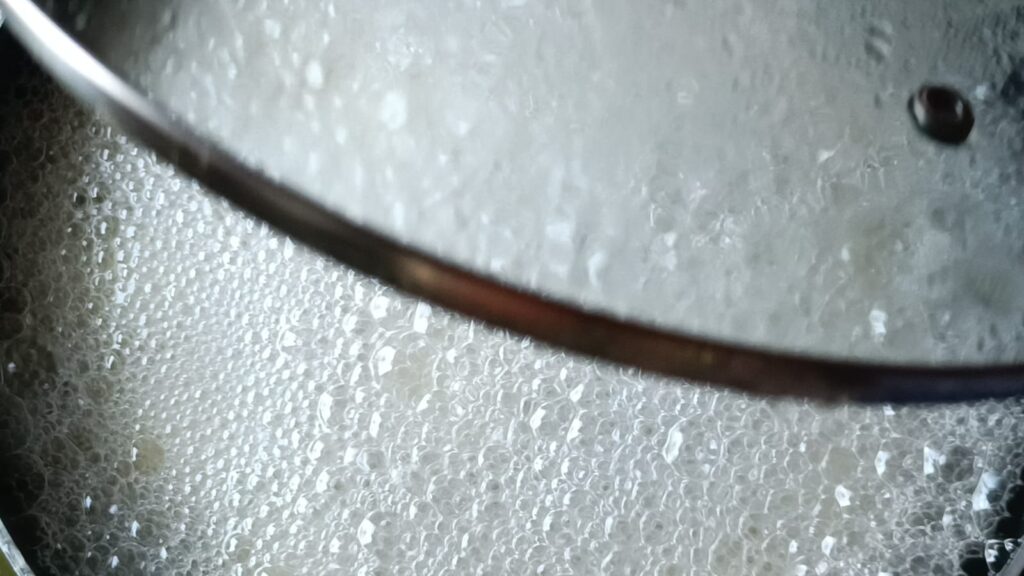
19. While the rasgullas are boiling, take some ice cubes in a bowl. Mix some sugar syrup which you have prepared earlier. After 10-12 mins you can see rasgullas are perfectly swelled up and cooked well. Switch off the flame.
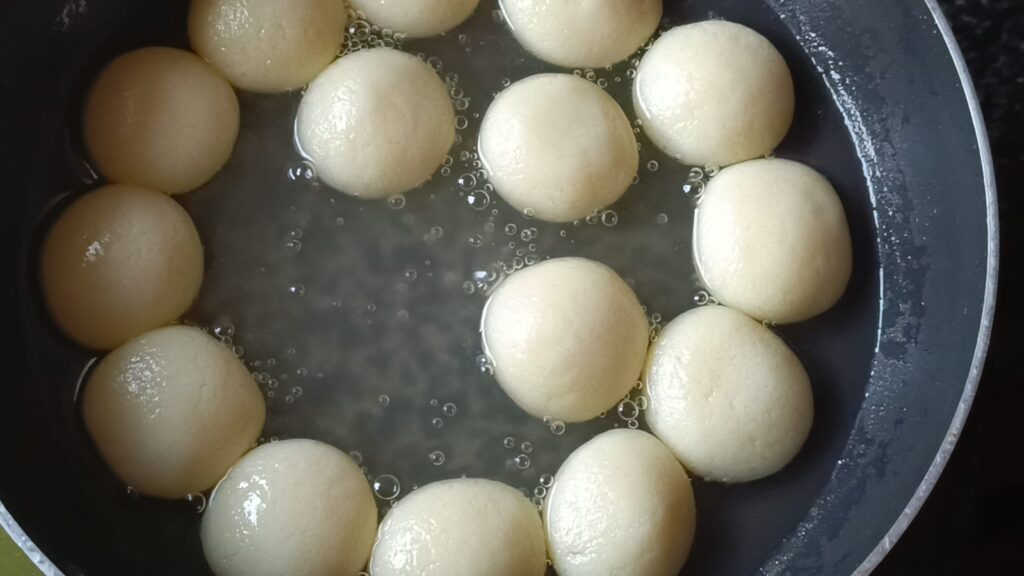
20. Transfer the rasgullas to the cold syrup immediately after cooking. What will happen, the cooking process of the rasgullas will be stopped immediately after adding in cold syrup. Close the bowl with a plate and keep it in refrigerator for 4 hours.
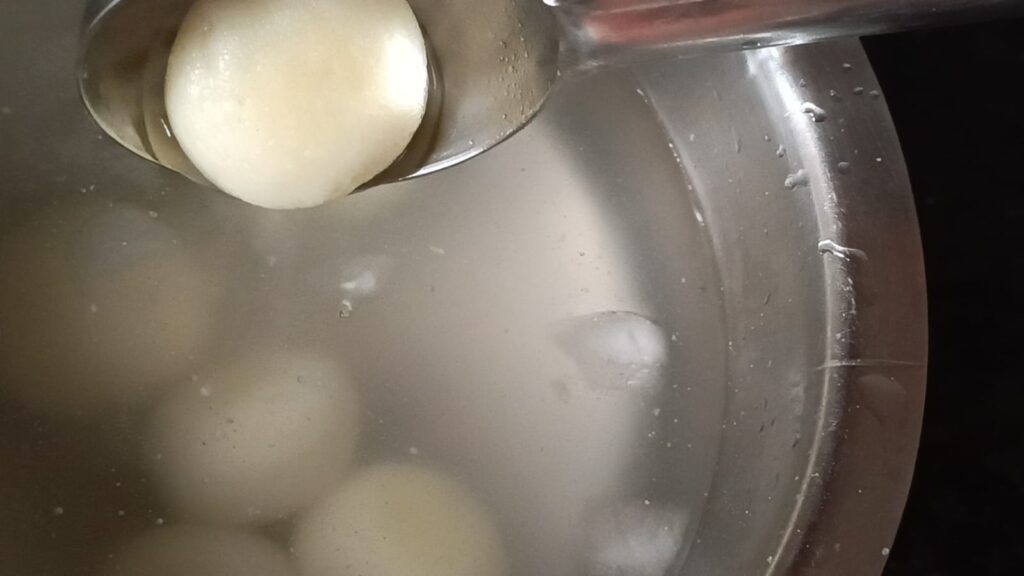
21. Take out the bowl from refrigerator after 4 hours and you can see the shape of the rasgullas are so perfect and fluffy. It is spongy and porous.
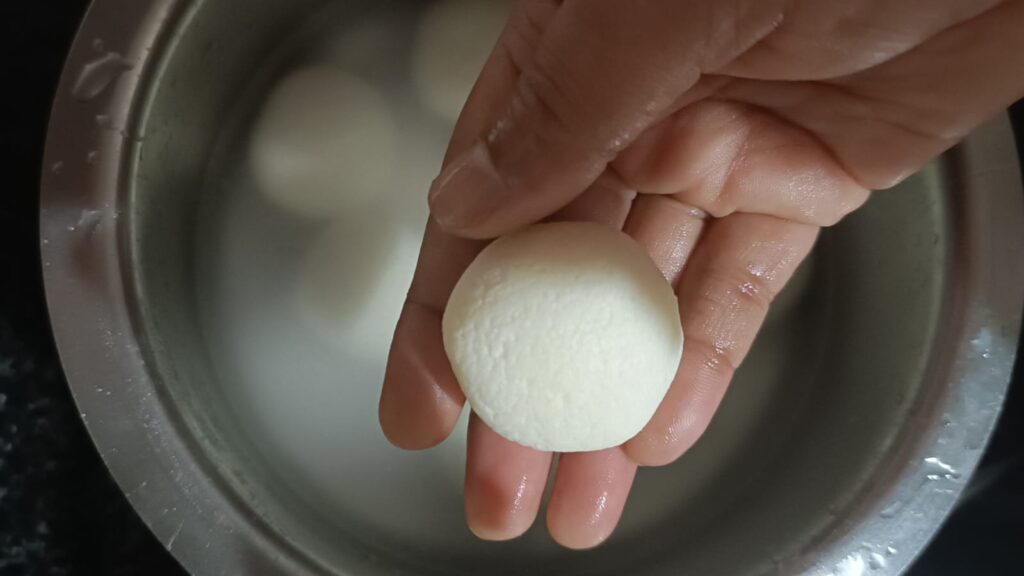
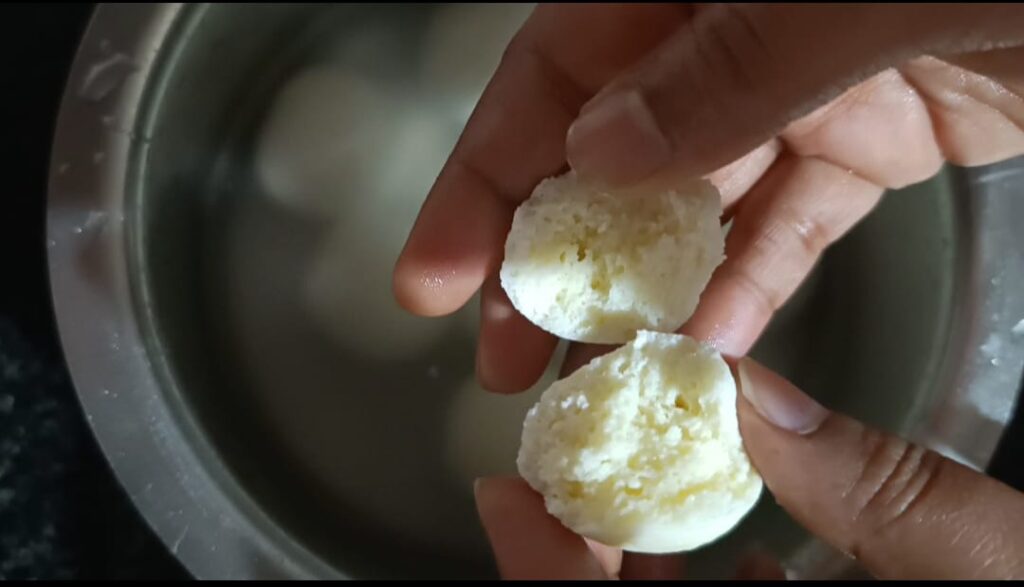
22. Now transfer all the rasgullas to the sugar syrup which was in room temperature and keep it for half an hour.

23. Now your super white sponge type and delicious, bengali rasgulla sweets are ready to serve.
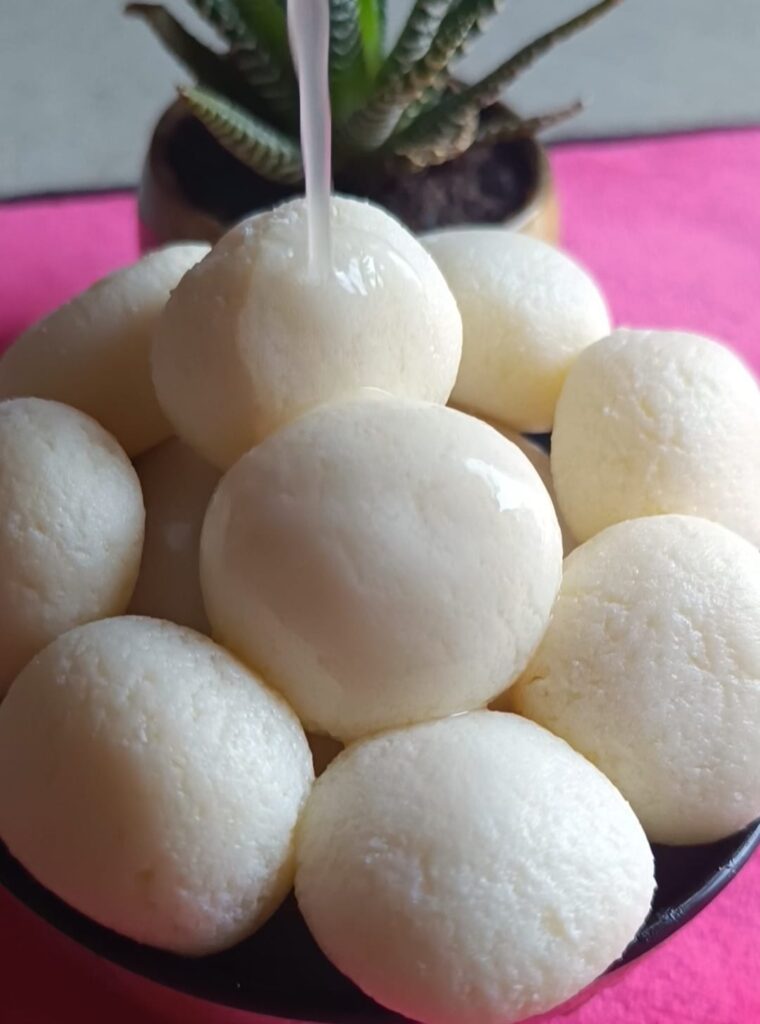

Preservation Techniques:
Traditional Methods of Preservation
Traditionally, bengali rasgullas were stored in clay pots, which helped keep them fresh and retain their moisture.
Modern Storage Solutions
Today, refrigeration has extended the shelf life of rasgullas, making it easier to enjoy them for days
Variations and Innovations:
Regional Varieties across India
Odia Rasgulla: Tracing the Origins
The debate between Odisha and Bengal over the true origin of rasgulla is well-documented, with Odisha’s version being slightly different in texture and taste.
Bengali Sponge Rasgulla: A Textural Delight
Bengali rasgullas are known for their ultra-soft, spongy texture, a result of the specific technique used in their preparation.
Other Regional Twists: Exploring Diversity
From the introduction of different flavors to alterations in texture, every region adds its own twist to the classic rasgulla.
Innovative Flavors and Modern Twists
Fusion Flavors: Experimenting Beyond Traditional
Chefs have begun infusing rasgullas with unconventional flavors like chocolate, strawberry, and even saffron, catering to the evolving palate of the modern sweet lover.
Diet-Friendly Variations: Catering to Health Consciousness
In response to health trends, sugar-free and low-fat versions of rasgullas are now available, making them accessible to those with dietary restrictions.
The Role of Chef Creations and Online Trends
Social media and culinary experimentation have introduced a wave of innovative rasgulla variations, merging tradition with modern tastes.
Cultural and Economic Impact:
Festivals and Celebrations: Rasgulla in Bengali Traditions
Rasgulla in Weddings and Pujas
No Bengali wedding or puja is complete without a serving of rasgulla, symbolizing sweetness and joy.
The Sweet Diplomacy: Rasgulla in Geopolitical Relations
The bengali rasgulla has played a unique role in Indian diplomacy, showcasing the rich culinary heritage of the region.
Rasgulla Day: A Celebration of Sweetness
The inception of ‘Rasgulla Day’ is a testament to its cultural significance, bringing people together in celebration of this sweet delight.
Economic Contributions
Local Sweetmeat Shops to Global Brands
From humble beginnings in local sweet shops, bengali rasgulla has found its way onto international dessert menus, thanks to brands that have globalized its production.
Employment and Livelihoods in the Rasgulla Industry
The rasgulla industry has been a source of livelihood for thousands, from artisans who craft each piece by hand to those involved in its large-scale production and distribution.
Challenges and Opportunities in the Global Market
While globalization has opened up new markets, it also poses challenges such as maintaining quality and authenticity.
Debates and Controversies:
The Odisha-West Bengal Geographical Indications (GI) Battle
Historical Claims and Evidence
Both states have presented historical evidence to claim the origin of rasgulla, leading to a spirited debate.
The GI Tag and Its Implications
The granting of the GI tag to West Bengal for “Banglar Rasogolla” has been a significant milestone, yet the debate continues.
Beyond the GI Tag: Cultural Exchange and Shared Heritage
Despite the controversies, the rasgulla remains a symbol of the shared cultural heritage and culinary genius of both regions.
Health Debates: Balancing Tradition with Dietary Concerns
Sugar and Calorie Content Concerns
The high sugar and calorie content of traditional rasgullas have raised health concerns.
Adaptations for Health: Sugar-free and Low-fat Options
Innovations in crafting healthier versions of rasgullas offer a compromise, blending tradition with dietary consciousness.
The Role of Traditional Sweets in Modern Diets
Moderation and innovation ensure that traditional sweets like bengali rasgulla continue to be enjoyed by all.
Conclusion:
Bengali Rasgulla is more than just a sweet; it’s a piece of cultural heritage, a token of celebration, and a testament to the inventive spirit of culinary traditions. As we look towards the future, the balance between innovation and tradition promises to keep the legacy of the Bengali rasgulla alive and cherished for generations to come. Here’s to many more years of melting sweetness!
You may also like this post: Rosgulla recipe
Frequently Asked Questions:
Q. What is the main ingredient of Bengali Rasgullas?
A. Paneer or cottage cheese is the main ingredient of bengali rasgullas, giving rasgulla its characteristic texture.
Q. How is Rasgulla different in Odisha and Bengal?
A. The primary difference lies in the texture and flavor, with Odia rasgullas being slightly denser and Bengal ones known for their sponginess.
Q. Can Rasgulla be made in different flavors?
A. Absolutely! Chefs and sweet shops are constantly experimenting with flavors, offering everything from rose to chocolate-flavored rasgullas.
Q. Is there a sugar-free version of Rasgulla for diabetics?
A. Yes, sugar-free versions are available, making it a guilt-free treat for those monitoring their sugar intake.
Q. How has the introduction of the GI tag affected the production of Bengali Rasgullas?
A. The GI tag has helped in asserting the geographical origin and ensuring quality standards for “Banglar Rasogolla.”
Q. What is the shelf life of Rasgulla?
A. When stored properly in the refrigerator, bengali rasgullas can last for about a week.
Q. Can Rasgulla be considered a healthy dessert option?
A. While traditional bengali rasgullas are high in sugar, there are now healthier versions available, making it possible to indulge in moderation.

Pingback: Delicious Veg Fried Rice Recipe for a Flavorful Meal
Your article helped me a lot, is there any more related content? Thanks!
Your point of view caught my eye and was very interesting. Thanks. I have a question for you.